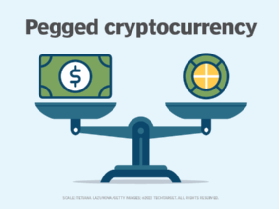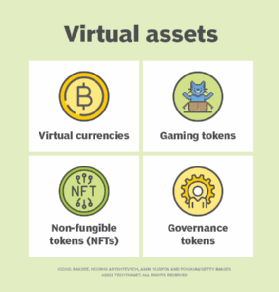pegged cryptocurrency
What is a pegged cryptocurrency?
A pegged cryptocurrency is a cryptocurrency whose value is linked to a specific bank-issued currency, financial instrument or tradable commodity. Since the bank-issued currency -- U.S. dollar (USD), British pound (GBP), euro (EUR), etc. -- is fiat currency, a pegged cryptocurrency is also known as a fiat-pegged cryptocurrency.
Regardless of which fiat currency or commodity it is linked to, the pegged cryptocurrency is an encryption-secured digital medium of exchange. The link or peg is determined by the exchange rate between the two currencies. Once this exchange rate is established -- usually, one to one -- the value of the cryptocurrency fluctuates in the same direction and to the same degree as the fiat currency to which it is pegged.
More about pegged cryptocurrencies
Pegging refers to linking the market value of a cryptocurrency to an external reference, which can be a fiat currency or a commodity. The pegged price of the cryptocurrency refers to the price it attempts to attain to minimize volatility. In reality, trades can happen at any price called the market price, which may be different from the pegged price. However, the ultimate aim of pegging is to ensure that the pegged price and market price are as closely aligned as possible.
Most pegged cryptocurrencies are pegged to USD because it is the dominant currency in the global financial sector, as well as one of the most stable fiat currencies in the world. Cryptocurrencies can also be pegged to commodities like gold or to currencies other than USD. For example, the Digix cryptocurrency is pegged to gold with the value of one DGX token equivalent to the value of one gram of gold.

Pegging the cryptocurrency to a fiat currency or commodity helps stabilize it by holding its value fairly steady. Such steadiness is essential if the cryptocurrency is to serve as a medium of exchange for real-world transactions, like purchases or payments.
Pegged cryptocurrencies don't soar in value, so they don't usually make their holders rich. However, their stability assures those who spend the cryptocurrency (e.g., shoppers) and those who accept the cryptocurrency (e.g., merchants) that it will retain its short-term purchasing power and protect them from volatility-induced losses.
Pegged cryptocurrencies and volatility
All unpegged cryptocurrencies are notoriously volatile due to factors like the following:
- marketplace perceptions of risk
- supply and demand
- investor sentiment
- media reports
- government regulations
Due to volatility, the price of cryptocurrencies fluctuates, often falling or rising by thousands of dollars -- or other fiat currencies -- in a matter of days. Pegging a cryptocurrency to a more stable fiat currency or asset can protect it from extreme levels of volatility. This helps minimize rapid and/or significant changes in value that could negatively impact anyone holding or trading in the currency.

Pegged cryptocurrencies and stablecoins
A pegged cryptocurrency is a type of stablecoin. Stablecoins combine the benefits of cryptocurrencies and fiat currencies. Like cryptocurrencies, they offer fast transactions, secure payments and user privacy. And, like fiat currencies, stablecoins offer volatility-free, stable valuations.
Of course, fiat currencies can -- and do -- depreciate or appreciate against other currencies, so their value falls or increases, respectively. However, the swings are usually small, so volatility is low. Stablecoins attempt to take advantage of this quality to provide a more stable cryptocurrency than regular cryptocurrencies. For these reasons, stablecoins are suitable for applications where highly volatile cryptocurrencies, like Bitcoin, cannot be used.
Pegged cryptocurrencies also offer holders a safe haven for their holdings since they are not subject to extreme market price swings. As a result, they can transact without having to convert their holdings into a fiat currency.
Examples of pegged cryptocurrencies
Most stablecoins are pegged to key currencies, such as EUR, GBP or USD. Tether is a popular cryptocurrency pegged to USD. A USD tether (USDT) maintains the same value as $1, indicating a 1-to-1 peg. Simply put, one USDT token is always valued at $1.
In 2020, Tether announced that the Solana blockchain would be one of its issuers. Tether is also available on these blockchains:
Tether is one of the most traded pegged crypto tokens since it can be exchanged for over 4,000 other cryptocurrencies on centralized exchanges.
The 1-to-1 alignment between the pegged cryptocurrency and the fiat currency usually happens via smart contracts. In addition, decentralized participants on the blockchain perform maintenance and governance activities. Smart contracts incentivize them to perform these functions and help maintain the 1-to-1 alignment.
Examples of other stablecoins pegged to USD are the following:
- USD Coin
- Binance USD
- TrueUSD
- Dai
- Pax Dollar
- Ampleforth
- Synthetix
In recent years, a number of non-USD-pegged stablecoins have emerged. Stablecoins pegged to EUR include the following:
- Euro Coin
- Stasis Euro
- Ageur
Similarly, Poundtoken is a stablecoin pegged to GBP. Tether also has crypto assets pegged to EUR, Mexican peso, GBP and Chinese yuan. These stablecoins can be redeemed one for one for the fiat currency they are pegged to.
How pegged cryptocurrencies hold their value
Unlike Bitcoin and other regular cryptocurrencies, a pegged cryptocurrency is designed to hold a steady, less volatile value. It holds its peg in one of three ways. One, it maintains a reserve of cash (fiat money) or cash-equivalent assets. The value of these assets approximately matches the total value of the stablecoin in circulation.
Two, it maintains a reserve of cryptocurrencies. However, these reserves are larger than the face value of their stablecoins. Such overcollateralization helps compensate for the volatility of the reserve cryptocurrency.
Three, the pegged cryptocurrency can operate as an algorithmic stablecoin.
What are algorithmic stablecoins?
An algorithmic stablecoin maintains its value because algorithmic operations automatically increase or decrease its supply. Like other cryptocurrencies, these are decentralized, meaning no centralized authority is involved in governance or backing the cryptocurrency.
Algorithmic stablecoins operate on blockchains containing smart contracts. These algorithms can be programmed to automatically respond to supply and demand swings to either create more units of the coin or to destroy existing units. When the coin trades above its pegged value, more tokens are created, so its price falls. When it trades below the peg, more tokens are taken out of the circulation. Since their number (supply) decreases, the price goes up.
Unlike pegged cryptocurrencies, whose value is rooted in their collateral -- a fiat currency or commodity -- the value of an algorithmic stablecoin is calculated by blockchain smart contracts. Additionally, it is unregulated and less centralized.
Pegged cryptocurrencies and reserve fiat currency
To be pegged to a specific type of asset, the owners of cryptocurrencies must hold a value in the asset they are pegged to that is sufficient to provide a guarantee. This enables them to convert the cryptocurrency to another type of asset if they choose to do so.
In addition, crypto developers who want to peg their cryptocurrency to a fiat currency must hold that currency in reserve at all times so they can back up their claim for stability. This ensures that, if the pegged cryptocurrency's value falls, holders can claim their share of fiat currency in exchange for their crypto tokens.
In reality, developers find it challenging to hold large amounts of fiat currency to back their pegged crypto tokens. This is why they often turn to investors and fundraising to build their fiat reserves.
Compare NFTs vs. cryptocurrency vs. digital currency, learn about virtual assets and explore a timeline and history of blockchain technology.